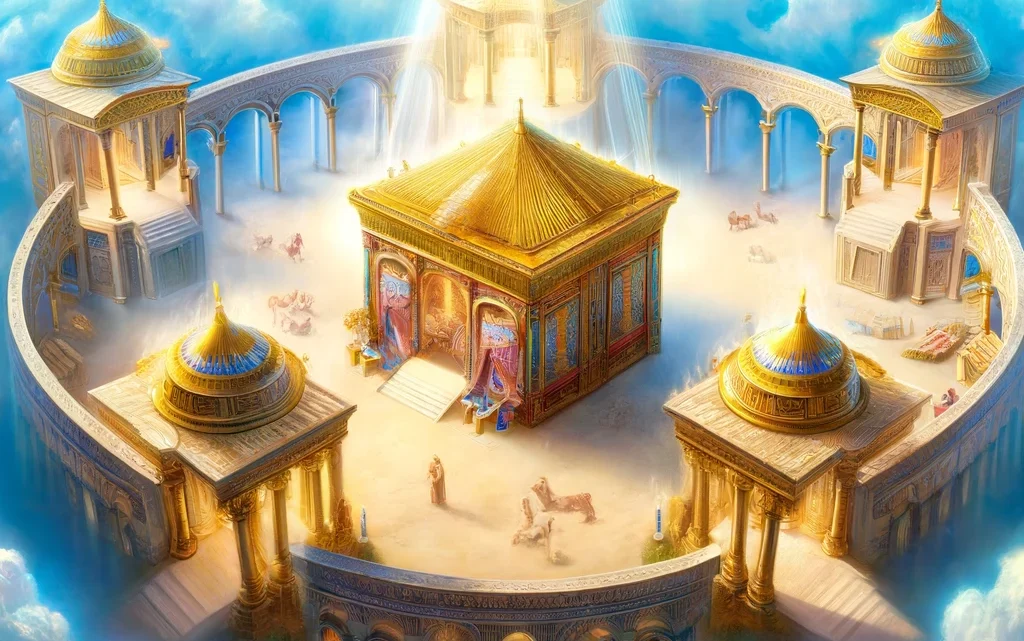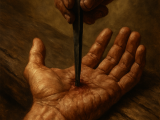The Heavenly Tabernacle: Understanding the Spiritual Blueprint of Moses’ Tabernacle

Introduction
The Tabernacle built by Moses in the wilderness was not just a physical structure, but a divine blueprint with profound spiritual significance. This post explores the symbolism of the Tabernacle and its implications for believers today, drawing connections to heavenly realities.
The Outer Court
Components: The Brazen Altar, The Laver
Description: The Outer Court was the area where sacrifices were made and washing occurred. The Brazen Altar was used for burnt offerings, and the Laver was for the priests to wash their hands and feet.
Spiritual Significance:
- Brazen Altar: Symbolizes the need for atonement and the sacrificial system, pointing to Yeshua’s ultimate sacrifice for sin.
- Laver: Represents purification and the importance of cleanliness, both physically and spiritually, before approaching God.
The Holy Place
Components: The Golden Lampstand, The Table of Showbread, The Altar of Incense
Description: The Holy Place was the first room within the Tabernacle where the priests performed daily rituals.
Spiritual Significance:
- Golden Lampstand: Symbolizes Yeshua as the light of the world and the illumination of the Holy Spirit.
- Table of Showbread: Represents Yeshua as the bread of life and the sustenance provided by God.
- Altar of Incense: Symbolizes the prayers of the saints ascending to God, indicating the importance of continual prayer and worship.
The Veil
Description: The Veil separated the Holy Place from the Holy of Holies. It was a thick curtain that only the High Priest could pass through once a year on Yom Kippur.
Spiritual Significance: The Veil symbolizes the separation between God and man due to sin. When Yeshua died, the veil in the Temple was torn, symbolizing the new access to God made possible through His sacrifice.
The Holy of Holies
Components: The Ark of the Covenant, The Mercy Seat
Description: The Holy of Holies was the innermost and most sacred area of the Tabernacle, containing the Ark of the Covenant. The Ark housed the tablets of the Law, Aaron’s rod, and a pot of manna. The Mercy Seat was the lid of the Ark where God’s presence would appear.
Spiritual Significance:
- Ark of the Covenant: Represents God’s covenant with His people and His faithfulness.
- Mercy Seat: Symbolizes God’s throne and His mercy. The blood sprinkled on the Mercy Seat on Yom Kippur represents atonement for sin.
Heavenly Realities
Scriptural Reference: Hebrews 8:5
- “Who serve unto the example and shadow of heavenly things, as Moses was admonished of God when he was about to make the tabernacle: for, See, saith he, that thou make all things according to the pattern shewed to thee in the mount.”
Description: The earthly Tabernacle was a shadow of the heavenly realities. The components and rituals point to greater spiritual truths and heavenly counterparts.
Spiritual Significance: Understanding the Tabernacle helps believers grasp the heavenly realities it represents, including the nature of worship, sacrifice, and God’s presence.
The New Tabernacle
Scriptural Reference: Revelation 21:3
- “And I heard a great voice out of heaven saying, Behold, the tabernacle of God is with men, and he will dwell with them, and they shall be his people, and God himself shall be with them, and be their God.”
Description: In the New Jerusalem, the ultimate fulfillment of the Tabernacle will be realized. God will dwell with His people eternally, and there will be no need for a physical structure because His presence will permeate everything.
Spiritual Significance: This points to the ultimate restoration and fulfillment of God’s plan to dwell with His people, highlighting the eternal communion and fellowship believers will enjoy with God.
Conclusion
The Tabernacle of Moses is more than an ancient relic; it is a spiritual blueprint that reveals profound truths about God’s nature, His relationship with His people, and His plan for redemption. By studying the Tabernacle, believers can gain deeper insights into their faith and draw closer to Yehovah.










